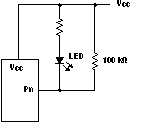SCPS129K August 2005 – March 2021 PCA9535
PRODUCTION DATA
- 1 Features
- 2 Description
- 3 Revision History
- 4 Description Continued
- 5 Pin Configuration and Functions
- 6 Specifications
- 7 Parameter Measurement Information
- 8 Detailed Description
- 9 Application Information Disclaimer
- 10Power Supply Recommendations
- 11Device and Documentation Support
- 12Mechanical, Packaging, and Orderable Information
9.2.1.1 Minimizing ICC When I/O Is Used To Control Led
When an I/O is used to control an LED, normally it is connected to VCC through a resistor as shown in Figure 9-3. Because the LED acts as a diode, when the LED is off, the I/O VIN is about 1.2 V less than VCC. The ΔICC parameter in Electrical Characteristics shows how ICC increases as VIN becomes lower than VCC. For battery-powered applications, it is essential that the voltage of I/O pins is greater than or equal to VCC, when the LED is off, to minimize current consumption.
Figure 9-2 shows a high-value resistor in parallel with the LED. Figure 9-3 shows VCC less than the LED supply voltage by at least 1.2 V. Both of these methods maintain the I/O VIN at or above VCC and prevent additional supply-current consumption when the LED is off.
 Figure 9-2 High-Value Resistor In Parallel With Led
Figure 9-2 High-Value Resistor In Parallel With Led Figure 9-3 Device Supplied By Lower Voltage
Figure 9-3 Device Supplied By Lower Voltage